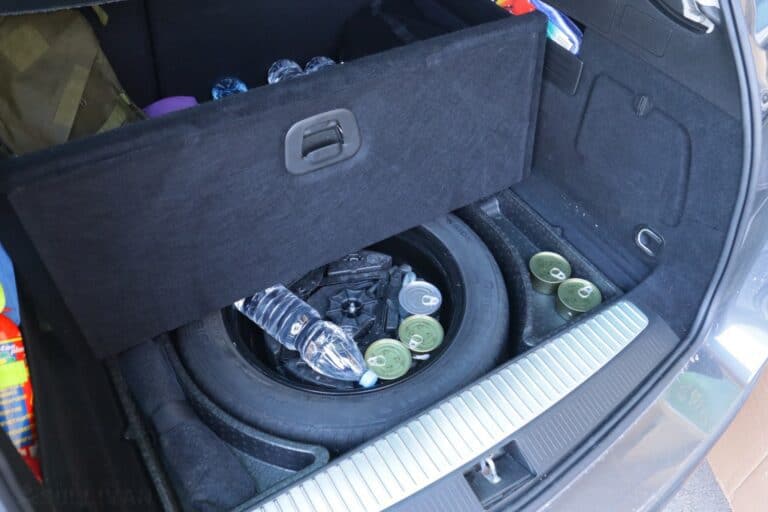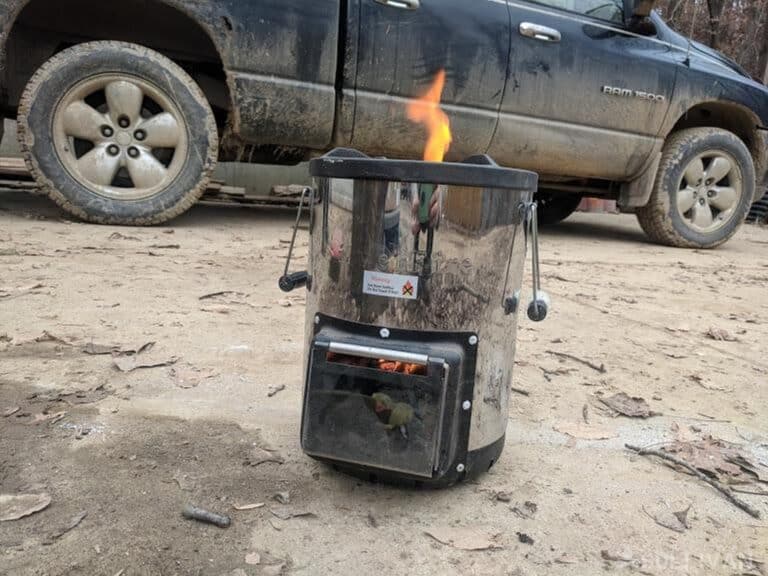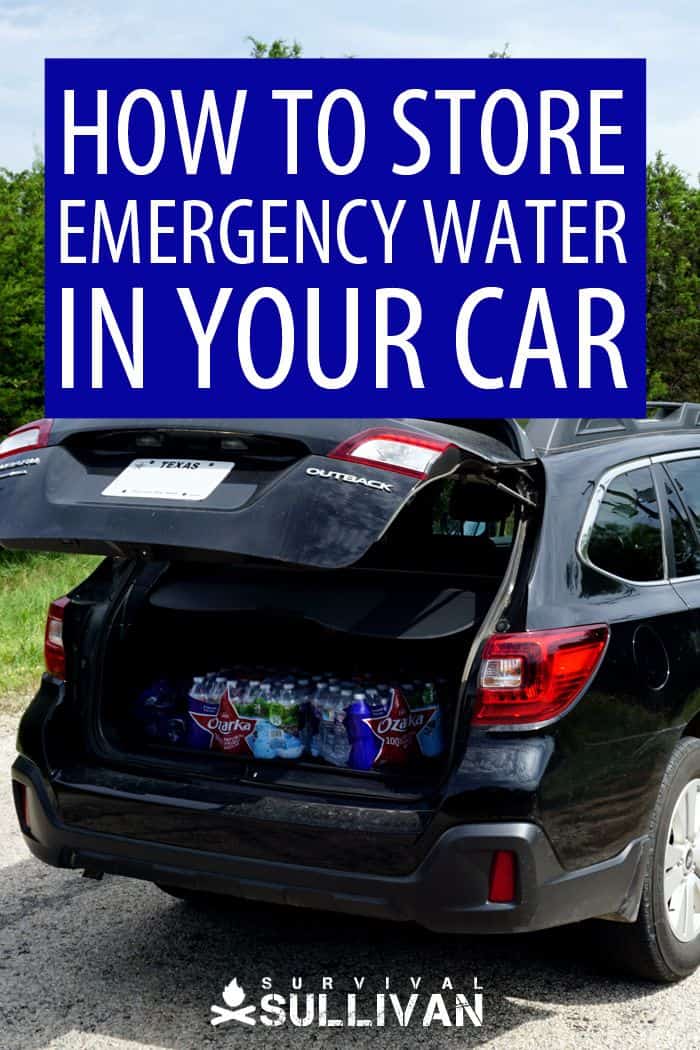Water is one of life’s essentials, so it should come as no surprise that having a stockpile on hand for emergencies is a must. But, while many focus on keeping emergency water stores at home, few realize the importance of having a small stockpile in your car.
That being said, storing water in a vehicle isn’t as easy as it might seem. While throwing a bunch of water bottles in your trunk might seem like a simple solution, doing so could be hazardous for you in the summer months.

On the other hand, improperly stored water can quickly freeze during the winter, making it difficult to use in a survival situation.
To ensure that you have all the information you need to properly store emergency water in your vehicle, I’ve created this complete guide to doing just that.
Up next, I’ll walk you through the most important things to know about water storage in a car or truck and give you some top tips for doing it right.
Table of Contents
Why You Need To Store Water In Your Car
Like it or not, we humans spend a lot of time in our cars each day. Even if you don’t have a long commute to work or you try to avoid long car drives, there’s always a chance that you might need some water while you’re in the car.
In fact, having a few gallons of water in your vehicle is helpful in a wide range of different situations. Here are just a few:
- Bugging Out. Having water already in your vehicle makes the bug out process way simpler and less stressful because that’s one fewer thing you need to worry about.
- Long Car Rides. If you unexpectedly get caught in traffic or are out on a long car ride, some extra water in your vehicle can help quench your thirst until you get home. This is especially important if you’re driving in a location where amenities are few and far between.
- Hiking And Camping. Should you be out and about on a fun camping or hiking trip, having that extra water on hand can be helpful should the trailhead or campsite not have a water supply for you to use.
- Medical Emergencies. Clean drinking water is a must if you want to properly care for and clean out open wounds. It can also be used to flush out eyes or cool a burn in an emergency.
- Radiator Issues. If your radiator is overheating and you don’t happen to have any coolant on hand, water can be used in a pinch to get you home. Just remember that water isn’t as effective at cooling as purpose-made coolant is, so be sure to top up with proper coolant as soon as possible.
- Winter Storms / Trapped In A Car. Should you ever get trapped in your car during a winter storm or some other natural disaster, you’ll have to rely on what you have in your car to be able to survive. While most people think of water as important in hot-weather survival situations, water is critical even when it’s cold outside. Having water on hand in your car if you get caught in a storm can help you stave off dehydration until you can safely get back home.
Additionally, you can also keep a water filter on hand in your vehicle. Something like a LifeStraw or chemical drops can help purify water on the go at most sources.
Keeping a water filter and some stainless steel containers are the best combination for a minimalist kit.
Problems With Storing Water In A Vehicle
Storing water in a car seems easy enough – just toss some plastic water bottles in the backseat or the trunk and you’ll be good to go, right?
Well, it turns out that this isn’t exactly the safest way to keep water in a vehicle. In fact, there are three main problems that people face when trying to store emergency water in their car: hot temperatures, waterborne illnesses, and freezing cold conditions. Here’s what you need to know:
Hot Temperatures
While 73ºF (22.8ºC) temperatures might seem nice and pleasant to most of us, according to the National Weather Service, a car sitting in these conditions can reach temperatures over 110ºF (43ºC) in just 45 minutes.
When it’s 93ºF (33.9ºC) outside, temperatures can reach nearly 140ºF (60ºC) in your car in only 1 hour. Needless to say, that’s hot!
A 2014 study from researchers at the University of Florida and Nanjing University found that plastic water bottles from 16 different brands that were left in a hot car for 1 week leaked significant amounts of chemicals from the plastic into the drinking water.
The chemicals that leaked from the plastic water bottles into the water include antimony, a known carcinogen, and BPA, which may cause a whole host of problems, including hormone disorders, metabolic disorders, tumors, and even cancer.
While many companies have, since that 2014 study, switched to BPA-free containers, there is still a risk of chemical contamination from other compounds, like antimony, when water bottles are left in hot environments. Therefore, knowing how to store water properly in hot environments is essential.
Cold Temperatures
Should you live somewhere that experiences very cold winters, freezing temperatures are going to be a big problem. Sure, frozen water isn’t dangerous, like hot water sitting in a plastic water bottle might be, but it certainly isn’t easy to drink.
In reality, frozen water isn’t very helpful if you’re stuck in a survival situation in the middle of the winter. While you could melt your frozen water, doing so consumes large amounts of time and fuel, which isn’t helpful when you’re trying to focus your efforts on staying warm.
Insulating the water in as many layers as possible is the best and most obvious solution in these situations…
Emergency Water Supply Contamination
Finally, regardless of the conditions that your car faces on a regular basis, there is still a risk of bacteria and other harmful pathogens infecting your water supply if it’s not stored properly.
How To Store Emergency Water In A Vehicle
How you store emergency water in your vehicle all comes down to the climate that you live in and the conditions that your car is going to face each day. This is what you need to know about properly storing emergency water in a car for when SHTF.
Storing Water In Hot Environments
Hot temperatures make storing water in plastic bottles in your car a not-so-good idea. Thankfully, there are plenty of great ways to store water in a car, even in a hot environment. Here are some top tips:
Use Non-Plastic Containers
While plastic containers can leach all sorts of nasty chemicals into your water, metal containers won’t, no matter how hot it gets outside.
Stainless steel and aluminum bottles and jerry cans can help prevent dangerous toxins from leaking into your water, even in really hot temperatures.
Metal containers are also quite durable. Should you drop them there is a better chance of a dent developing rather than a broken bottle. In the cold, plastic tends to become brittle.
The downside to using metal containers is that they can get really warm in hot conditions. But, if I personally had to choose between warm water and dangerous chemicals, I’d probably go with the former.
Consider A Cooler
Even a cooler that’s not filled with ice can help to insulate your water supply from the heat. The temperature fluctuations aren’t as intense due to the cooler acting as a buffer.
A cooler can act as a good second layer of protection against the heat for your emergency water. Soft coolers are generally more convenient for use in a car, but hard-sided models with extra insulation are usually more effective.
Choose Canned Emergency Water Instead of Bottled Water
If you’d rather have your vehicle water stockpile packaged up in smaller serving sizes, rather than one large container, canned emergency water is the way to go.
Companies like Blue Can sell emergency water with a 50 year shelf-life, which is perfect for long-term storage. Plus, these cans are designed to withstand conditions between 38ºF and 140ºF (3.3ºC to 60ºC), so they’re a good option for keeping in a car that frequently experiences hot weather.
The main drawback to canned emergency water is the cost. But, since it has such a long shelf life, you probably won’t have to replace it very frequently.
Additionally, canned water is much easier to fit into a smaller car than a large metal container, so it’s much more practical for people with sedans or limited space in their vehicle.
Just keep in mind that canned emergency water isn’t suitable for very cold conditions because it can result in your container bursting.
So, if you live somewhere with big temperature swings from season to season, you might want to have two separate water storage systems for your car.
Storing Water In Cold Environments
The primary concern with storing water in cold environments is the fact that water freezes at a relatively high temperature (32ºF / 0ºC) compared to the temperatures we face during the winter months. For many of us, below-freezing temperatures are a fact of life and we’ve learned to cope.
But, our emergency water supply can easily freeze in the back of our vehicles if not properly prepared. Consider the following tips for car storage during the winter:
Use A Cooler
While an insulated cooler might seem like something you’d use when you want to keep water cold, they’re actually just as effective at keeping items warm as they are at keeping them cold.
So, keeping your emergency water in a cooler within your vehicle is a must for any time of year. In the summertime, your cooler will shelter your stockpile from the heat and in the wintertime, it can help protect your water from freezing.
Again, hard-sided coolers are more effective than soft-sided coolers, but either one is better than nothing.
Get Insulating Materials
In addition to using a cooler, there are a lot of materials you can use to insulate your water from the cold.
Survival blankets are really good at trapping in heat, so you can use them to add another layer of protection for your water during the winter. Consider wrapping survival blankets around your water containers before placing them in a cooler.
Additionally, you can take old foam camping sleeping pads (which are very good at insulating against the cold) and use them to further line the inside of your cooler.
They can even provide a bit of padding for the inside of your cooler to stop your water bottles or containers from rattling around in the back as you drive your car.
Don’t Fill Up Your Containers All The Way
Water expands when it freezes, making it different from most other naturally-occurring liquids, which normally contract when frozen.
The problem with water expanding when frozen is that ice can easily crack a container, especially those made from glass.
In general, it’s best to avoid using glass as a container for your vehicle’s emergency water storage because it can easily crack, but expanding water is a problem for nearly any type of container, regardless of material.
To avoid any problems with expanding water and cracked containers during the winter months, be sure to leave a bit of empty space in your containers. As a general rule, leave at least 1/4 to 1/3 of the container empty to provide enough room for the water to expand in the cold.
Pack A Camp Stove
Hopefully you already have a portable stove in your car’s bug out bag, but if not, having one is a must for anyone that lives in a cold environment. This is because, despite your best efforts, your water stockpile may still freeze in the winter months.

If you have a camp stove on hand, you can use it to melt enough water for drinking in an emergency situation. Plus, camp stoves are essential for cooking freeze-dried food and other emergency supplies that you might have in your car, so it’s best to have one, just in case.
Where To Store Water In Your Vehicle
Once you understand how to store water in your car, it’s time to talk about where to actually put it. There are two main places where you can store water in your vehicle:
Trunk/Hatchback
The trunk of a vehicle is often seen as the most obvious place to store water and other emergency supplies. Storing water in the trunk has a few primary advantages:
- Doesn’t Affect Seating Space. When you place emergency supplies in the back of your car, you don’t have to worry about it taking up space in the cabin.
- Prevents Flying Debris In An Accident. Although we all hope to never get in a car accident, it’s important to minimize any potential hazards in your vehicle that could be dangerous during an collision.
- Stays Cooler Than The Cabin. If you have a car with a separate trunk compartment, this area actually tends to stay a bit cooler than the central cabin of the car in hot months since the sun can’t reach it.
Cabin
The cabin of your car can also be a good place to store emergency water, particularly in cold climates. Here are some of the advantages of keeping water in your vehicle’s cabin:
- Stays Warmer In The Winter. Since you probably turn on the heat of your car as you drive during the winter months, it’s easier to stop water from freezing if it’s in your vehicle’s cabin. At the very least, your water supply will get a blast of hot air whenever you drive, which can make a difference in the long run.
- More Accessible In An Emergency. Should you ever get trapped in your car during a snowstorm, you might not be able to get out of the vehicle to access water that’s stored in the trunk. So, having water stored in the cabin of your car makes it much more accessible from within should you be stuck in your vehicle for a few hours or even days.
Emergency Water Is Essential
An emergency stockpile of water in your vehicle is a must for any prepper. However, properly storing your water is essential if you want to ensure that it’s safe and drinkable when you need it most.
Water storage in a car really depends on where you live and the weather conditions that you face. For people who live in areas with both hot summers and cold winters, having two separate water storage systems – one for cold weather and one for hot weather – is often the best way forward.


Gabrielle is a professional outdoor educator, mountain guide, and survival expert with a passion for helping others be prepared for whatever might come their way. She is a polar guide in the Arctic region and is an experienced wilderness medicine instructor/EMT.

If canned water freezes, won’t it split the can?
Yes, that is why they say that a particular brand of canned water is designed for temperatures from 38 degrees to 140 degrees, and that in cold weather, canned water can “explode”.